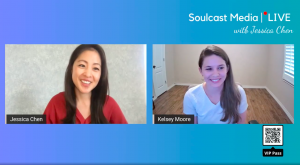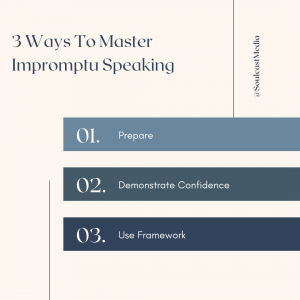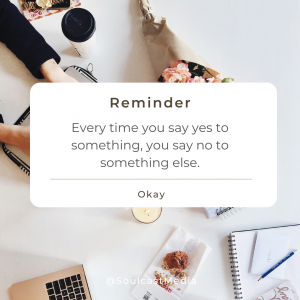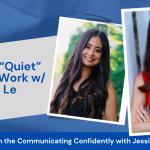Mastering Impromptu Speaking
Whether we realize it or not, almost all of our conversations are impromptu. Our coworker asks us what we did over the weekend, or our team leader asks us about the project status. We didn’t spend time preparing notes for these conversations, which happened spontaneously and organically. However, our anxiety may rise when we are called on during a meeting or asked a question we weren’t prepared for. According to Quantified, speakers are 19% less confident when impromptu speaking. This is why learning how to prepare for spontaneous speaking situations is essential.
 Our CEO and Founder, Jessica Chen, recently hosted a Soulcast Media | LIVE event on LinkedIn, where she interviewed Communications Coach | Soulcast Media, Kelsey Moore.
Our CEO and Founder, Jessica Chen, recently hosted a Soulcast Media | LIVE event on LinkedIn, where she interviewed Communications Coach | Soulcast Media, Kelsey Moore.
They shared tips and personal stories about mastering impromptu speaking and its importance to career success.
What is Impromptu Speaking?
Giving a speech or having a conversation about a topic without much preparation ahead of time is considered impromptu speaking. Impromptu speaking situations can include talking to our boss, being put on the spot during a meeting, or being asked a question we weren’t prepared for. Impromptu speaking may lower our speaking confidence, but there are several ways we can prepare for spontaneous situations.
1. Preparation
Remember being called on during a meeting and put on the spot to answer a question? When this happens, we often have a physical response to this situation. Our palms may start to sweat, and our heart rate may increase. This response is completely normal. However, it can cause us to blurt out an answer, or become tongue-tied. The key to overcoming this is to prepare.
Consider the following:
- Practice – Even though impromptu conversations are spontaneous, we can prepare for them to boost our speaking confidence. For example, one way to prepare is to practice having our partner, friend, or colleague pepper us with rapid-fire questions. The goal is to get us comfortable thinking and speaking on the spot. We will be able to train ourselves to remain calm and think quickly. This will help us when the situation arises in a meeting or any other impromptu speaking situation.
- Manage Fight Or Flight – Often, when we are put on the spot, our anxiety takes over, and we cannot clearly communicate our response. We will want to manage our fight-or-flight response to avoid this. One way to do this is to reframe how we think about the situation. For example, we can give ourselves a moment to collect our thoughts. We’ve heard the question. We are going to think about what they asked. And then, we will respond. Breaking it down into small pieces will help us reframe how we think about the situation.
- Down/Up Technique – Another great way to help us manage our anxiety is to practice the down/up method. When put on the spot, we can look down and nod our heads as if we are thinking about the answer. Take a breath to collect ourselves. Then, raise our heads and give our response. This gives us a moment to really think about what we want to say, and prevents us from blurting out an answer.
Even though impromptu conversations are on the fly, we can still prepare for them when they happen. Reframing how we feel in those situations and practicing techniques to manage our fight or flight will help boost our confidence when speaking.
2. Demonstrate Confidence
Impromptu speaking tends to lower our speaking confidence. This is primarily because we aren’t given any time to write down our thoughts and rehearse our responses. However, it is essential for us to demonstrate confidence, even in these circumstances.
Consider the following:
- Silences – To demonstrate confidence, we need to get comfortable with silences. Silences can prevent us from blurting something out, using filler words, or giving away too much information. When we are comfortable with silence, we show confidence.
- Avoid Filler Words – During the Soulcast Media | LIVE, Kelsey shared how filler words can be used to hold the floor. In other words, we use these words to ensure the other person knows we have something to say and we don’t want to be interrupted. However, using these words makes us appear less confident about what we are saying. To avoid using these words, we need to practice the up/down method technique. This will give us time to collect ourselves and prepare a response.

- Don’t Uptalk – Uptalk is when we end a statement with a higher tone of voice, making it seem like we are asking a question. This shows we aren’t sure about our answer. To avoid this, we must ensure our tone is down when we end our statement. We can record ourselves asking a question, and then listen back to hear how our tone of voice goes up. Then, record ourselves speaking a statement. Notice how our tone of voice goes down. When our tone of voice goes down, it indicates we’ve finished our thought and are confident in our response.
Demonstrating confidence is critical when learning how to master impromptu conversations. Being comfortable with silences, avoiding filler words, and working on our tone of voice will help us project confidence.
3. Use Framework
During the Soulcast Media | LIVE, Jessica shared how it can be challenging to practice clear communication when put on the spot. She said to ensure we are clear in our communications; we will want to organize our thoughts and responses using a framework.
Consider the following:
- Car Method – During the Soulcast Media | LIVE, Kelsey shared the CAR method framework. CAR stands for Context, Action, and Result. She said we can use this framework to organize our thoughts when responding. For example, if our boss calls on us during a meeting and puts us on the spot, we can prepare our answers using the CAR method. Think about the context in which the question has been asked. Then, consider what action we have taken or what actions others have taken. After that, think about the results. We can use this framework to organize our thoughts before we respond.
- Provide Context – As we organize our thoughts, providing context first will help our communications. For example, if our boss asks us questions, we can think about what high-level context we need to give first. Then, we can go into the details. If our boss asks us how the project is going, we can respond with something like, “We’ve finished the first round of A/B testing. The results from the A group were XYZ, and the results from the B group were XYZ. We are analyzing the results to come up with the best option.” When we start high level, we can quickly fill in the details.
- Use Chronological Order – When formulating our response, we can use chronological order as our framework. For example, think about what happened first, next, etc. This will help us quickly organize our thoughts before we give an answer.
Clearly communicating our responses when put on the spot can be difficult. A framework to organize our thoughts will help us clearly communicate our answers.
4. Saying No On The Spot
One of the hardest things to do when put on the spot is to say no. We may really want to help someone out, but the truth is we can’t take on every project. There are several ways we can say no on the spot.
Consider the following:
- EOT Method – During the Soulcast Media | LIVE, Jessica shared the EOT method. EOT stands for explain, offer options, and tone. For example, first, we explain why we can’t do something. We can say our plate is full, or we have a deadline we need to meet. Then, we offer options. We can ask them to circle back after our deadline is over. Last, remember our tone of voice. We always want to be mindful of how we are saying no. We want to keep our tone professional.
- Company Impact – Another way to say no on the spot is to talk about the impact this will have on the company. For example, we can say, “We would be happy to take on this project; however, it will take us away from XYZ project. Which project would you prefer we focus on?” In this way, we can say no by reminding the person of the overall company impact.

- Consider Others – Another way to say no is to bring someone else into the mix. For example, we can say, “Our plate is full, but we know Erika is a great resource. You should reach out to her and see if she can help.” In this way, we are saying no but giving an alternative person to ask.
Every time we say yes to something, we say no to something else. We need to be mindful of how we are saying no, and be sure to offer alternatives.
Mastering impromptu speaking is a skill we can learn. We can focus on preparing ourselves for these situations, and remember to organize our thoughts with framework techniques. The more comfortable we are with silence, the more confident our communications will be.
Check out Jessica’s Youtube Channel if you want to see the full LIVE version of Jessica and Kelsey’s conversation.
__
Whenever you’re ready, there are 3 ways we can help you:
- Discover your communications style so you know where to start. Over 4,000 people have found theirs here.
- Attend our monthly communication workshop to build communications confidence (new topics: public speaking, advocating for yourself, building credibility, etc) here.
- Get your brand in front of 43k+ people by sponsoring our newsletter or Soulcast Media | LIVE LinkedIn events [contact: hello@soulcastmedia.com]











